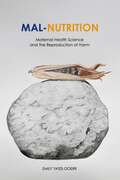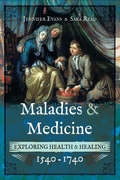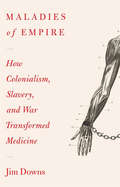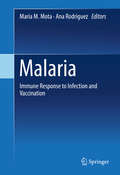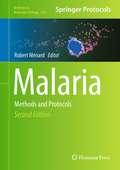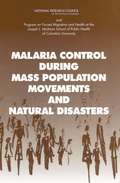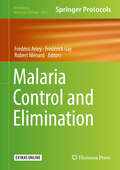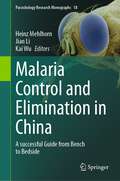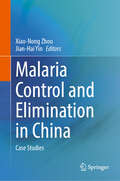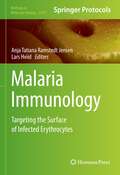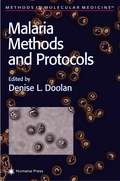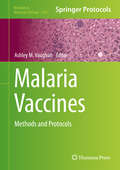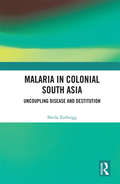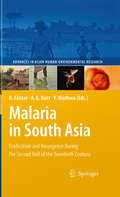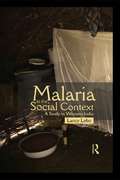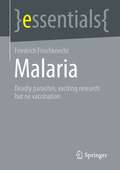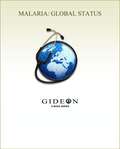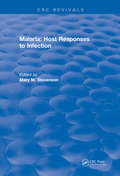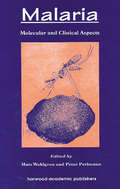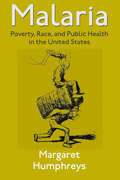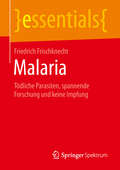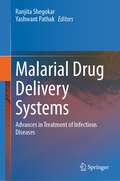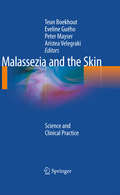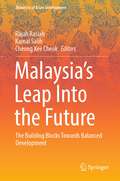- Table View
- List View
Mal-Nutrition: Maternal Health Science and the Reproduction of Harm
by Emily Yates-DoerrA free ebook version of this title is available through Luminos, University of California Press’s Open Access publishing program. Visit www.luminosoa.org to learn more.Mal-Nutrition documents how maternal health interventions in Guatemala are complicit in reproducing poverty. Policy makers speak about how a critical window of biological growth around the time of pregnancy—called the "first 1,000 days of life"—determines health and wealth across the life course. They argue that fetal development is the key to global development. In this thought-provoking and timely book, Emily Yates-Doerr shows that the control of mothering is a paradigmatic technique of American violence that serves to control the reproduction of privilege and power. She illustrates the efforts of Guatemalan scientists, midwives, and mothers to counter the harms of such mal-nutrition. Their powerful stories offer a window into a form of nutrition science and policy that encourages collective nourishment and fosters reproductive cycles in which women, children, and their entire communities can flourish.
Maladies & Medicine: Exploring Health & Healing, 1540–1740
by Jennifer Evans Sara ReadA lively account of medical practices in early modern England: &“Superb . . . an essential piece of social history.&” —Books Monthly It was an era when tooth cavities were thought to be caused by tiny worms and smallpox by an inflammation of the blood, and cures ranged from herbal potions, cooling cordials, blistering the skin, and of course letting blood. Maladies and Medicine tells the story of how the body was understood before the major advances of modern medicine, covering the theory of the four humors and the ways that male and female bodies were conceptualized. It also explains the hierarchy of healers, from university-trained physicians to the women who traveled the country offering cures based on inherited knowledge of homemade remedies, as well as the print explosion of medical health guides, which began to appear in the sixteenth century, from more academic medical textbooks to cheap almanacs. In twenty chapters discussing attitudes toward, and explanations of, some of the most common diseases and medical conditions of the period, the book reveals the ways people understood them and the steps they took to get better. It examines the body from head to toe, from migraines to gout. Case studies and personal anecdotes taken from doctors&’ notes, personal journals, diaries, letters, and even court records show the reactions of individuals to their illnesses and treatments, bringing us into close proximity with people who lived roughly four centuries ago. This richly illustrated study will fascinate those curious about the history of the body and the way our ancestors lived.
Maladies of Empire: How Colonialism, Slavery, and War Transformed Medicine
by Jim DownsA sweeping global history that looks beyond European urban centers to show how slavery, colonialism, and war propelled the development of modern medicine. Most stories of medical progress come with ready-made heroes. John Snow traced the origins of London’s 1854 cholera outbreak to a water pump, leading to the birth of epidemiology. Florence Nightingale’s contributions to the care of soldiers in the Crimean War revolutionized medical hygiene, transforming hospitals from crucibles of infection to sanctuaries of recuperation. Yet histories of individual innovators ignore many key sources of medical knowledge, especially when it comes to the science of infectious disease. Reexamining the foundations of modern medicine, Jim Downs shows that the study of infectious disease depended crucially on the unrecognized contributions of nonconsenting subjects—conscripted soldiers, enslaved people, and subjects of empire. Plantations, slave ships, and battlefields were the laboratories in which physicians came to understand the spread of disease. Military doctors learned about the importance of air quality by monitoring Africans confined to the bottom of slave ships. Statisticians charted cholera outbreaks by surveilling Muslims in British-dominated territories returning from their annual pilgrimage. The field hospitals of the Crimean War and the US Civil War were carefully observed experiments in disease transmission. The scientific knowledge derived from discarding and exploiting human life is now the basis of our ability to protect humanity from epidemics. Boldly argued and eye-opening, Maladies of Empire gives a full account of the true price of medical progress.
Malaria
by Maria M. Mota Ana RodriguezCurrently, malaria kills more than 300,000 people per year, making it a top priority of world leaders and international organizations, who are working towards implementing and coordinating efforts to eradicate this disease. An effective malaria vaccine is recognized as the key element that will decide between success and failure in this fight. At present, despite intensive research efforts, such a vaccine is not yet available for use. However, there are a number of advanced candidate vaccines with high chances of success in the short term. Malaria: Immune Response to Infection and Vaccination provides a comprehensive view on the immune response to malaria and to the different vaccines under development. The book offers the following: - Contributions by top research leaders in the field, - Comparisons of the immune responses to both malaria infection and malaria vaccines, which are traditionally treated separately, - Coverage of the immune responses to the different stages of malaria, which are frequently treated as separate fields of research.
Malaria
by Robert MénardOver the past ten years, many powerful new techniques have been developed that have dramatically changed malaria research. The second edition of Malaria: Methods and Protocols expands upon the previous edition with current, detailed techniques for laboratory research. With new chapters on parasite culture techniques, genome manipulation methods, 'omic' approaches, and techniques for studying the biology of the red blood cell and pre-erythrocytic stages of Plasmodium. Written in the highly successful Methods in Molecular Biology series format, chapters include introductions to their respective topics, lists of the necessary materials and reagents, step-by-step, readily reproducible laboratory protocols, and tips on troubleshooting and avoiding known pitfalls. Authoritative and practical, Malaria: Methods and Protocols, Second Edition, offers a comprehensive set of standard techniques for laboratory researchers.
Malaria Control During Mass Population Movements And Natural Disasters
by Peter B. BlolandAdmittedly, the world and the nature of forced migration have changed a great deal during the last two decades. The relevance of data accumulated during that time period can now be called into question. The roundtable and the Program on Forced Migration and Health at the Mailman School of Public Health of Columbia University have commissioned a series of epidemiological reviews on priority public health problems for forced migrants that will update the state of knowledge. "Malaria Control During Mass Population Movements and Natural Disasters--the first in the series--provides a basic overview of the state of knowledge of epidemiology of malaria and public health interventions and practices for controlling the disease in situations involving forced migration and conflict.
Malaria Control and Elimination (Methods in Molecular Biology #2013)
by Robert Ménard Frédéric Ariey Frédérick GayThis detailed book serves to provide a global overview of the goals, rationale, and scientific basis for malaria control and elimination, as well as tools, methods, and strategies to that end. Opening with a section on malaria epidemiology, the volume continues by covering tools that are critical to malaria management, anti-malarial drugs and resistance to these drugs, vaccination approaches against malaria, vector control, as well as some perspective on the future of the fight against this devastating disease. Written for the highly successful Method in Molecular Biology series, chapters in this collection feature the kind of practical, hands-on advice that leads to better results in the field. Authoritative and important, Malaria Control and Elimination is a valuable reference for all those involved in malaria control and elimination worldwide, from students to health practitioners and field researchers seeking to make eradication a reality wherever possible.
Malaria Control and Elimination in China: A successful Guide from Bench to Bedside (Parasitology Research Monographs #18)
by Jian Li Heinz Mehlhorn Kai WuThis volume provides cutting-edge research from malaria parasitology and records the success story of disease control in China. The country, which was certified malaria-free by the World Health Organization in 2021, looks back on 70 years of effort and fruitful combat history.Expert authors supply insights from Plasmodium morphology to the clinical picture of malaria, molecular and immunodiagnosis, as well as current treatment and resistance issues, making this book a valuable blueprint for further success stories. The present work makes a significant contribution to the Sustainable Development Goal (SDG) 3, Good Health and Well-Being, with the aim to end malaria epidemics by 2030. Practical details of malaria elimination tools and strategies are completed by chapters on artificial intelligence in diagnosis and also traditional Chinese medicines for therapy. All researchers involved in malaria control and elimination around the globe will benefit from the knowledge presented, including students, scientists, policy makers at various levels, and professionals in healthcare and antiparasitic drug discovery.
Malaria Control and Elimination in China: Case Studies
by Xiao-Nong Zhou Jian-Hai YinThis book intends to provide the lessons and efforts on malaria control and elimination practices in several classical endemic areas with different transmission characteristics. The book collects seven cases on malaria surveillance and response based on the 1-3-7 approach in Jiangsu Province, the border malaria control and elimination in Yunnan Province, the fight against malaria among forest goers in the mountainous areas in Hainan island, the focal mass drug administration for Plasmodium vivax control in Anhui Province, the vector control response to malaria re-emergence in Henan Province, and the review of discovery history of artemisinin, as well as the international promotion of ACTs. The book is likely to be of interest to professionals/practitioners and policy makers in government or industry in the field of malaria control and prevention, and related researchers, especially in the malaria transmission areas targeting malaria elimination.
Malaria Immunology: Targeting the Surface of Infected Erythrocytes (Methods in Molecular Biology #2470)
by Anja Tatiana Ramstedt Jensen Lars HviidThis volume covers a broad range of methods, technologies, and protocols on malaria. Chapters detail research on collecting parasites in the field, single molecule-level analyses of adhesive interactions, and focused studies aiming at disrupting the devastating disease. Written in the format of the highly successful Methods in Molecular Biology series, each chapter includes an introduction to the topic, lists necessary materials and reagents, includes tips on troubleshooting and known pitfalls, and step-by-step, readily reproducible protocols. Authoritative and cutting-edge, Malaria Immunology: Targeting the Surface of Infected Erythrocytes aims to be a useful and practical guide to researches to help further their study in this field. Chapter Analysis of var gene transcription pattern using DBLα-tags [Chapter 14] is available open access under a Creative Commons Attribution 4.0 International License via link.springer.com.
Malaria Methods and Protocols
by Denise L. DoolanInternationally respected scientists and clinicians describe in step-by-step detail their most useful conventional and cutting-edge techniques for the study of malaria. Areas covered include clinical and laboratory diagnosis and typing, animal models, molecular biology, immunology, cell biology, vaccinology, laboratory models, and field applications. Each readily reproducible protocol has been tested, standardized, and optimized for experimental success, and includes many laboratory notes on troubleshooting, avoiding pitfalls, and interpreting results. Several of the most widely used methods are described here in detail for the first time or have been thoroughly updated since their original publication (e.g., in vitro culture of Plasmodium parasites and in vitro growth inhibition assay).
Malaria Vaccines
by Ashley VaughanThis volume focuses on malaria vaccinology, and introduces researchers to a complete overview of the protocols and tools used by molecular and cellular malariologists. The chapters within this book talk about interventions concerning all aspects of life cycle progression--measuring antibody responses to blood stage parasite survival, the T Cell responses engendered by attenuated sporozoite vaccinations, and the unique effect on transmission of antibodies that target the mosquito stage of the life cycle. Additionally, methods concerning the ability to generate targeted gene deletions and replacements in the genome of Plasmodium parasites convey how Plasmodium parasite phenotypes can be created to precise specifications. More recently, the potential power of humanized mouse models of disease progression have been demonstrated and are also discussed in the book. Written in the highly successful Methods in Molecular Biology series format, chapters include introductions to their respective topics, lists of the necessary materials and reagents, step-by-step, readily reproducible laboratory protocols, and tips on troubleshooting and avoiding known pitfalls. Cutting-edge and thorough, Malaria Vaccines: Methods and Protocols is a useful and unique resource for any aspiring malaria vaccinologists because of the volume's exquisitely detailed methodologies that are not typically found in published literature.
Malaria in Colonial South Asia: Uncoupling Disease and Destitution
by Sheila ZurbriggThis book highlights the role of acute hunger in malaria lethality in colonial South Asia and investigates how this understanding came to be lost in modern medical, epidemic, and historiographic thought. Using the case studies of colonial Punjab, Sri Lanka, and Bengal, it traces the loss of fundamental concepts and language of hunger in the inter-war period with the reductive application of the new specialisms of nutritional science and immunology, and a parallel loss of the distinction between infection (transmission) and morbid disease. The study locates the final demise of the ‘Human Factor’ (hunger) in malaria history within pre- and early post-WW2 international health institutions – the International Health Division of the Rockefeller Foundation and the nascent WHO’s Expert Committee on Malaria. It examines the implications of this epistemic shift for interpreting South Asian health history, and reclaims a broader understanding of common endemic infection (endemiology) as a prime driver, in the context of subsistence precarity, of epidemic mortality history and demographic change. This book will be useful to scholars and researchers of public health, social medicine and social epidemiology, imperial history, epidemic and demographic history, history of medicine, medical sociology, and sociology.
Malaria in South Asia
by Rais Akhtar Ashok K. Dutt Vandana WadhwaThis highly topical book provides an in-depth account of the South Asian experience with the deadly disease that has held this region hostage for millennia. The book touches specifically on the resurgence of malaria experienced in the second half of the twentieth century, which occurred just a few years after malaria was thought to have been virtually eradicated from the region. The progress of this reappearance across space and time, as well as its causes and consequences, are discussed. The book also covers past, present and future ways to curb, control and ultimately, conquer malaria. As malaria continues to ravage the developing world, even in today's 'age of science', this is a particularly relevant book, especially as most studies analyze the problem in Africa, the continent that bears the brunt of this disease. Here, the authors call attention to challenges in South Asia, home to an immense at-risk population. The chapters in this book use a range of conceptual frameworks, quantitative analyses and descriptive aapproaches, finding that malaria is not just a complex disease driven by highly adaptive agents and vectors thriving in particular ecologies, but also a social concern deeply related to the region's cultural traditions, financial and developmental shortfalls, and inexorably related to political will. The book comprehensively deals with all aspects of the malaria situation in South Asia, and is invaluable to upper level students as well as emerging and established scholars in the fields of medical geography and epidemiology, Asian studies and development studies.
Malaria in the Social Context: A Study in Western India
by Lancy LoboThis book underscores how, apart from bacteriological factors, human behavioural characteristics as well as the socio-cultural factors that affect people’s lives contribute to the risk for and prevention of infection, with particular focus on malaria. It argues that the implementation of malaria-control measures can be successful only if it considers the human response to malaria and control measures. Any new tool which is introduced in a particular area — be it a new vaccine, a new drug combination, the promotion of impregnated bed nets, spraying of insecticides, or improved home management — will be effective and sustainable only if it is adapted to needs of the local population, i.e., if it makes sense to them. This volume also studies traditional knowledge systems with respect to health and malaria, arguing that local knowledge about infection is the result of an amalgamation of the biomedical and the traditional. By attempting to identify how traditional and biomedical elements interrelate in local illness concepts, it hopes to assist health interventionists in providing efficacious health education and awareness among people.
Malaria: Deadly parasites, exciting research and no vaccination (essentials)
by Friedrich FrischknechtFriedrich Frischknecht gives an insight into malaria and the biological complexity of the parasites that trigger it. The author takes the reader on a journey from the historical discovery of the pathogen to the modern methods of vaccine development. He explains how genetic manipulations help to understand the parasite and to develop novel vaccination approaches. He explains the difficulties that need to be overcome to eradicate malaria.The author: Prof. Dr. Friedrich Frischknecht studied biochemistry at the Freie Universität Berlin and did his PhD on smallpox viruses at the European Molecular Biology Laboratory (EMBL) in Heidelberg. After a research stay at the Institut Pasteur in Paris, he has been head of a research group at the University Hospital in Heidelberg since 2005 and is interested in the molecular basis of the movement of malaria parasites.
Malaria: Global Status 2010 edition
by Dr Stephen Berger Gideon InformaticsMalaria: Global Status is one in a series of GIDEON ebooks which summarize the status of individual infectious diseases, in every country of the world. Data are based on the GIDEON database (www.gideononline.com) which relies on standard text books, peer-review journals, Health Ministry reports and ProMED, supplemented by an ongoing search of the medical literature. Chapters are arranged alphabetically, by country name. Each section is divided into five subsections. 1. Descriptive epidemiology 2. Summary of clinical features 3. Global status of the disease 4. Status of the disease in a specific country 5. References
Malaria: Host Responses to Infection (CRC Press Revivals)
by Mary M. StevensonThe purpose of this book is to analyze and determine how a host responds to a blood stage malaria infection. It focuses on strategies for anti-malarial vaccination, genetic control of host resistance to malaria, and the contribution of the host genetic background to resistance or susceptibility to malaria. This book is an important reference work for anyone who studies the field of microbiology, immunology, or parasitology.
Malaria: Molecular and Clinical Aspects
by Mats Wahlgren Peter PerlmannMalaria causes more death and disease than any other parasitic pathogen known today. This multiauthored text covers the important areas of malaria research, particularly focusing on those sectors which are of clinical importance for the understanding of the disease, the parasite, and its vector. The chapter authors are all leading experts withi
Malaria: Poverty, Race, and Public Health in the United States
by Margaret HumphreysThis is the story of a war against a disease that we can never win but must continue to fight.In Malaria: Poverty, Race, and Public Health in the United States, Margaret Humphreys presents the first book-length account of the parasitic, insect-borne disease that has infected millions and influenced settlement patterns, economic development, and the quality of life at every level of American society, especially in the south.Humphreys approaches malaria from three perspectives: the parasite's biological history, the medical response to it, and the patient's experience of the disease. It addresses numerous questions including how the parasite thrives and eventually becomes vulnerable, how professionals came to know about the parasite and learned how to fight them, and how people view the disease and came to the point where they could understand and support the struggle against it. In addition Malaria: Poverty, Race, and Public Health in the United States argues that malaria control was central to the evolution of local and federal intervention in public health, and demonstrates the complex interaction between poverty, race, and geography in determining the fate of malaria.
Malaria: Poverty, Race, and Public Health in the United States
by Margaret HumphreysFrom a prominent medical historian, “a fascinating story of the spread of malaria through the USA following its introduction in the seventeenth century” (Nature Medicine).Margaret Humphreys presents the first book-length account of the parasitic, insect-borne disease that has infected millions and influenced settlement patterns, economic development, and the quality of life at every level of American society, especially in the south and during its peak in the nineteenth century.Humphreys approaches malaria from three perspectives: the parasite’s biological history, the medical response to it, and the patient’s experience of the disease. It addresses numerous questions including how the parasite thrives and eventually becomes vulnerable, how professionals came to know about the parasite and learned how to fight it, and how people view the disease and came to the point where they could understand and support the struggle against it.In addition Malaria: Poverty, Race, and Public Health in the United States argues that malaria control was central to the evolution of local and federal intervention in public health, and demonstrates the complex interaction between poverty, race, and geography in determining the fate of malaria.“A masterpiece . . . recommended reading for anyone involved in or interested in health care.”?Southern Medical Journal“The lack of jargon makes the book accessible to a wide audience.”?Journal of the History of Medicine
Malaria: Tödliche Parasiten, spannende Forschung und keine Impfung (essentials)
by Friedrich FrischknechtFriedrich Frischknecht gibt einen Einblick in die Malaria und die biologische Komplexität der sie auslösenden Parasiten. Der Autor nimmt den Leser mit auf eine Reise von der historischen Entdeckung der Erreger zu den modernen Methoden der Impfstoffentwicklung. Dabei erläutert er, wie genetische Manipulationen helfen, den Parasiten zu verstehen und neuartige Impfansätze zu entwickeln. Er erläutert die Schwierigkeiten, die zur Ausrottung von Malaria zu überwinden sind.Der Autor: Prof. Dr. Friedrich Frischknecht hat nach dem Studium der Biochemie an der Freien Universität Berlin am Europäischen Molekularbiologischen Laboratorium (EMBL) in Heidelberg über Pockenviren promoviert. Nach einem Forschungsaufenthalt am Institut Pasteur in Paris leitet er seit 2005 eine Forschungsgruppe am Universitätsklinikum in Heidelberg und beschäftigt sich mit den molekularen Grundlagen der Bewegung von Malariaparasiten.
Malarial Drug Delivery Systems: Advances in Treatment of Infectious Diseases
by Yashwant Pathak Ranjita ShegokarThis book targets new advances in areas of treatment and drug delivery sciences for Malaria. This is the only published book which compiles the complete road map of malarial drug delivery systems along with an overview on the pathology, current state of malaria across the globe, new clinical trials, emerging drugs and evolving novel drug delivery platforms. A wide variety of novel micro-and nano-formulations using promising technologies are being explored to deliver the malarial drug via different administration routes. This book addresses the gap between new approaches and old treatment modalities and how the former is superior in pharmacological performance when tested in in-vitro and in-vivo. Audience from wide range group like from researchers to regulatory bodies can benefit from the compiled information to find out patient needs and addresses a much-needed update to the existing malaria drug delivery research.
Malassezia and the Skin
by Peter Mayser Aristea Velegraki Teun Boekhout Eveline Guého-KellermannThis book, written by a group of acknowledged experts, is the first comprehensive overview on the very unusual yeasts of the genus Malassezia. All relevant aspects of the genus and its 13 species are covered in detail within 11 chapters. The first chapter reviews the long and controversial history of the genus, while the second describes all mycological characteristics of the different species, including media and techniques adapted to their isolation, description, and maintenance. Subsequent chapters methodically address issues such as the effect of Malassezia yeasts on human and animal health, and the current therapeutic approaches for Malassezia-induced or -exacerbated diseases. The last chapter provides a summary of data to be presented on a website that will be regularly updated, thus incorporating latest findings. Microbiologists, mycologists, dermatologists, and veterinarians will find this book a useful and up-to-date source of information.
Malaysia’s Leap Into the Future: The Building Blocks Towards Balanced Development (Dynamics of Asian Development)
by Rajah Rasiah Kamal Salih Cheong Kee CheokThis book presents the future development of Malaysia. It puts together building blocks to achieve a better future. These blocks are poverty and income inequality, population, demography and urbanization, growth and technological progress, education, human capital and skills, finance, labor, the environment, and health care. It examines the reasons for the decline in the agricultural sector with an emphasis on food security. It discusses Malaysia’s economic growth and structural change compared to some of the Northeast East Asian and Southeast Asian countries. It explains the projections of population and demographic change and its bearing on government policies. It evaluates the country’s education sector and discusses the strategies to improve its role in the country further. It argues for replacing ethnic-based approaches with a needs-based system for the future direction to build a plural Malaysia. This insightful book is of interest across several fields, including demography, economic development, and urbanization.
